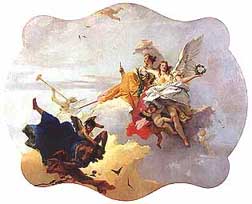Giovanni-Battista or Giambattista Tiepolo was born in Venice on March 5th 1696 and was with his brother-in-law Francesco Guardi one of the most charming painters of the Venetian school of the 18th Century. His father, a wealthy seaman, died when he was one-year old leaving six children.

The Triumph of Virtue and Nobility over Ignorance,
c. 1740-1750
The Norton Simon Foundation
Giambattista studied painting in Venice with Gregoria Lazzarini between 1717 and 1719 and married Cecilia Guardi with whom he had five sons and four daughters.
Much influenced by Paolo Caliari and Piazzetta, Tiepolo soon found his own style thanks to his incredible creative talents.
He first worked in Venice during twenty years and also in Udinese in 1726, in Milan in 1731, in Bergamo in 1733 and near Vienna in 1737.
Much active, he also worked in Würzburg between 1750 and 1753 and again in Venice from 1753 until 1761 before going to Madrid in 1762. There he produced some frescoes for the royal palace with the help of his two sons, Domenico and Lorenzo.
Tieopolo was affected at the end of his life in Madrid by the jealousy and intrigues fomented by his insipid rival Raphael Mengs.
Tiepolo painted some extraordinary frescoes and ceilings, notably for the chapel of Santa Teresa in Venice around 1720 and in the Capella Colleoni in Bergamo in 1733.
He executed other frescoes in the rooms of the Villa Valmarana in San Sebastiano, near Vicence with the help of his son, then aged 10, in the Jesuit Church, in the Palazzo Labia, in the Palazzo Rezzonico, in the Santa Maria della Pieta chapel as well as many oil paintings in the Palazzo Ducale, the Palazzo Crotta, the Scuola del Carmine, the Church of San Paolo, the church of della Fava, in Milan in the Palazzo Dugnani, the Palazzo Clerici, the Palazzo Arerinti, in Wurzburg, in the Escurial Palace in Madrid, in the Palace of Aranprez, in Montechin Maggiore near Vienna, in Padua and many other places.
Usually Tiepolo would prepare an oil sketch, sometimes two, for his large paintings and painted many genre and carnival scenes. He also produced quantities of drawings and etchings.
Tiepolo had a major impact on many painters of the 18th Century, Venetians or foreigners alike. He died in Madrid on March 17th 1770. His paintings are rated between US $ 80,000 for small formats and 800,000 for his major works.